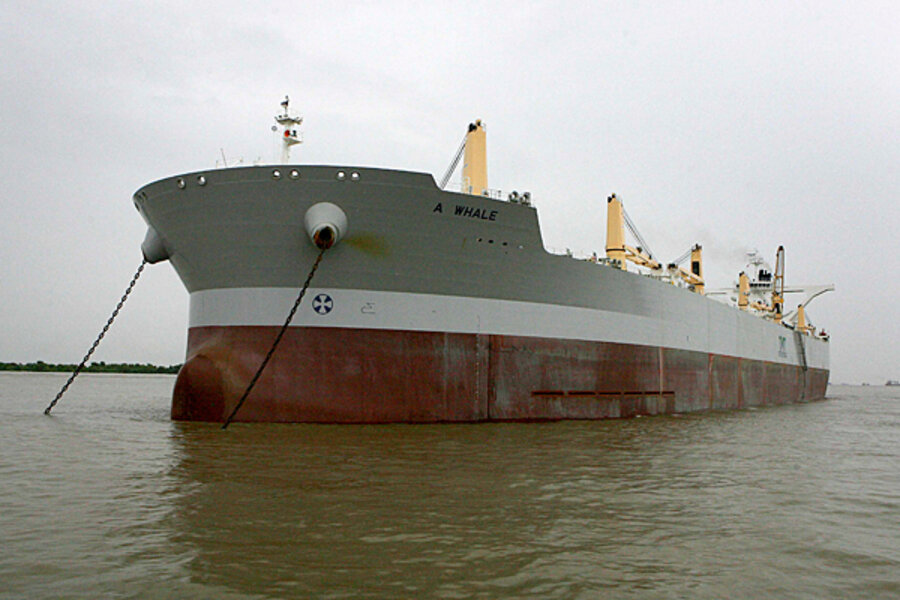A Whale to the rescue: Can super-skimmer turn tide of Gulf oil spill?
Loading...
| Atlanta
At 1,100 feet long, the A Whale is a super-skimmer for a super-spill. Or at least that's the sales pitch.
The 10-story-tall A Whale, a former iron ore carrier converted over a 10-day period in June to an oil-slurping behemoth by Taiwanese shipping mogul Nobu Su, dwarfs other ships at the Boothville, La., docks as it readies for 48 hours of testing in the Gulf over the weekend.
If approved by BP and the joint incident command in New Orleans, the A Whale could provide a much-needed scaling up of oil-skimming capacity in the Gulf. More than 500 medium to small oil skimmers – a five-fold increase since early June – are still largely losing the race to clean up oil escaping from the Macondo well ever since the Deepwater Horizon rig exploded on April 20, killing 11 and causing what this week became the largest oil spill ever in the Gulf of Mexico.
IN PICTURES: The Gulf oil spill's impact on nature
Moreover, Mr. Su and his A Whale are likely to test EPA and Coast Guard red tape that, critics say, has stood in the way of ramping up oil-collection efforts across the Gulf.
"The big hidden story of the Gulf oil spill is lack of capacity, and the A Whale could be key to turning that around and forcing the issue" of excessive red tape, says former Oklahoma Rep. Ernest Istook, now a fellow at the Heritage Foundation in Washington.
As BP and the Obama administration have struggled to respond to the oil spewing from the Deepwater Horizon blowout, oil is washing ashore from Pensacola, Fla., to Venice, La. – a testament, critics say, to the lack of skimming capacity in and around the spill.
Norwegian cleanup protocol, for example, calls for skimmers with a minimum capacity of 9,700 barrels of oil a day (407,400 gallons a day) to work a major offshore spill. The largest vessels currently in the Gulf have a 4,000-barrel-a-day capacity.
The Obama administration has been hammered for not calling in larger international skimmers sooner in the spill cleanup, a situation that's now changing.
But retired Coast Guard Adm. Thad Allen, the US pointman on the spill, says the main challenge of the spill is that it "presents ... as a massive collection of smaller patches of oil," which is why the spill unified command is ramping up the numbers – not necessarily the size – of vessels, aiming to put 750 skimming vessels to work by mid-July.
“From the beginning, our response has been dynamic to match the ever-shifting threat posed by this disaster, and that is why in early June we aggressively increased our focus on skimmers to combat the oil leaking from BP’s well,” Allen says. “We will continue to fight oil with as many skimmers as we can bring to bear on the water, while looking at every possible option for marshalling additional assets to impacted areas along the entire Gulf Coast."
Moreover, the EPA will likely have to take a careful look at the A Whale, since it decants the oily mixture and discharges the water back into the Gulf. Most skimmers now at work corral an oil-water mixture that is then separated on shore.
To date, skimmers in the Gulf have collected 671,000 barrels (28.2 million gallons) of oil and water mix from the Gulf. At the highest estimates of 60,000 barrels of oil a day flowing from the well, more than 4 million barrels of crude could have leaked into the Gulf already.
Collection efforts at the wellhead averaged 25,000 barrels a day before hurricane Alex skirted past, briefly stopping the siphoning activities. The collection capacity at the bottom of the Gulf could double after another collection vessel, the Helix, arrives on the scene in the next few days.
The A Whale, for its part, could collect more than 125 times the amount of the largest skimmer currently working the Gulf. It's capable of slurping up 300,000 barrels of oil (21 million gallons) of oil in 10 hours, and offloading it to a companion vessel, A Elephant. Mr. Su is already readying two other retrofitted tankers, the B Whale and C Whale, for service in the Gulf.
If approved, A Whale – which has a main stack decorated with a blue whale – would be used near the wellhead, where the oil is the thickest on the surface but where boat traffic is also the heaviest. It uses 12 large intakes to collect surface oil in its path.
Not everyone is convinced A Whale is the right ship for the job. Confronting a widely dispersed spill like the one in the Gulf, a large tanker like the A Whale might not be efficient enough to make its operation worthwhile, says Dennis Bryant, a former Coast Guard officer and now a maritime consultant in Gainesville, Fla.
"This would be using a very large ship that's very expensive to operate to tackle something that, in my mind, it's not going to be particularly good at," says Mr. Bryant. "It could be very good in other situations, but I don't think that this is the spill for it."
IN PICTURES: The Gulf oil spill's impact on nature
Related:





